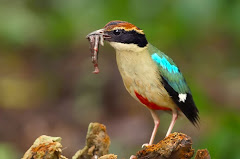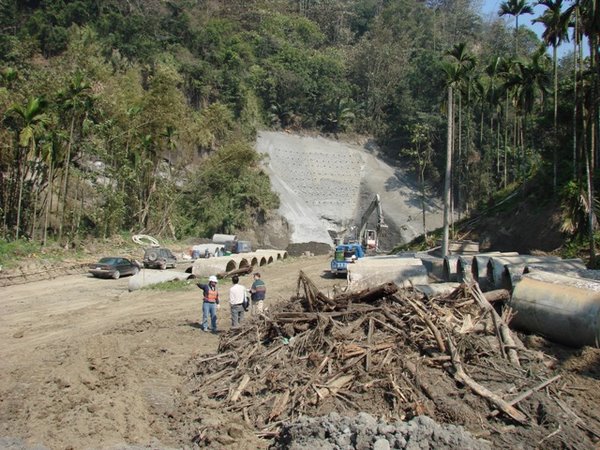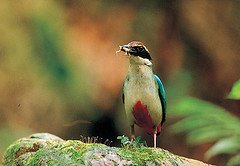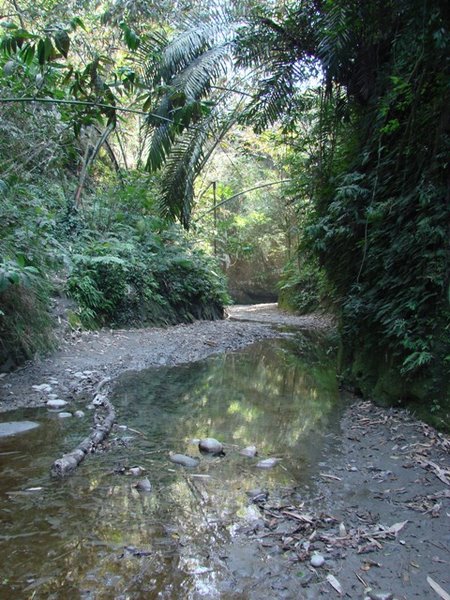Updated !!!: See MFCU accepting applications for Second Training Course for Volunteer Land-based Dolphin Observers and Interpretation Staff.
The Matsu Fish Conservation Union will be holding two sessions of its annual training program to promote awareness of the plight of a highly endangered Eastern Taiwan Strait population of Indo-Pacific humpback dolphins Sousa chinensis. The dolphins inhabit the estuarine waters along Taiwan's west coast and are seriously threatened by reclamation of estuarine and coastal regions for industrial purposes; by-catch in fishing gear; diversion and extraction of freshwater from major river systems of western Taiwan; release of industrial, agricultural and municipal effluent into rivers and coastal waters; noise and disturbance associated with construction, shipping and military activities.
The one-day-training-sessions will include lectures by leading cetacean scientists, researchers and ecologists on humpback dolphin history, habitat, threats and measures that can be taken to reduce the likelihood of the humpback dolphin's extinction.
The training program will be directed primarily at persons who would like to participate in our awareness and conservation campaigns. The first two sessions this year will be held a times roughly corresponding with the calming of the coastal waters that begins around the time of the birthday of the goddess of the sea, Matsu, which falls on 28 April this year (lunar calendar 23d day of the third month).
Session 1: 12 April 2008 Providence University, Taichung County.
Session 2: 19 April 2008 Yunlin County, Venue TBA.
All sessions are currently planned to be held in Mandarin Chinese, however, if there is sufficient demand (at least five persons) we will be happy to arrange for an English language course. Note that depending on demand there will be more sessions scheduled throughout the coming months.
For more details please e-mail us: comment@wildatheart.org.tw
Updated !!!: See MFCU accepting applications for Second Training Course for Volunteer Land-based Dolphin Observers and Interpretation Staff.
Monday, March 31, 2008
Taiwan Humpback Dolphin Training Program
Posted by
Wild at Heart Legal Defense Association
at
11:37 PM
0
comments
![]()
Buzzards and Butterflies - ecotourism opportunities going begging

Taiwan plunged 22 places on the Geneva-based World Economic Forum's (WEF) Travel and Tourism Competitiveness Report for 2008. With more focus on environmental sustainability this year, Taiwan only managed to achieve the 103rd place for natural resources which sealed the nation's abysmal score.
From mid March to mid April west-central Taiwan hosts two spectacular natural events. Beginning in mid March thousands of raptors, mostly Grey-faced Buzzard Butastur indicus and Chinese Sparrowhawk Accipiter soloensis, migrate through Taiwan on their journey north and gather around the Baguashan area in west-central Taiwan. Starting in late March one of the largest butterfly migrations on the planet unfolds as multitudes of Purple Crow Butterflies (Euploea genus) migrate through Huben, Hushan and Ping Ding.
Most people have never heard of these amazing events. That's not surprising considering that very little effort is made by the Taiwan Government to promote these events internationally and develop the ecotourism potential they offer. We've yet to see a single foreign face other than a Taiwan-based foreign naturalist at both these events this year. It was the same story last year and the year before.
The authorities should really be looking at the ecotourism potential of the Huben-Hushan area and the adjoining Baguashan area rather than trashing these environmentally important areas and using them as an opportunity to breathe new life into Taiwan's declining tourism industry.

See:
Huben and the Purple Butterflies
A Brief History of Grey-Faced Buzzard Conservation in Taiwan
Posted by
Wild at Heart Legal Defense Association
at
12:50 PM
0
comments
![]()
Saturday, March 29, 2008
Search for the Fairy Pitta wintering area
The location of the Fairy Pitta's wintering area remains somewhat of a mystery. It has long presumed to be the island of Borneo but in reality that is somewhat of an educated guess. There are a handful of confirmed winter Fairy Pitta sightings from Borneo so it would appear that at least some Fairy Pitta are present during winter.
Dr Lin Reuy-shing of the Taiwan Endemic Research Institute is presently in Sarawak, Borneo, following up on a November 2007 Fairy Pitta sighting made in the area of the Matang Wildlife Centre. We wish him success and eagerly await word of how he's been getting on.
Update !
See: Fairy Pitta wintering area mystery continues
Also see:
Australia's first Fairy Pitta and a winter sighting on Borneo
Posted by
Wild at Heart Legal Defense Association
at
10:58 AM
0
comments
![]()
Friday, March 28, 2008
Hushan Hearing Rescheduled to Allow More Preparation
At a preparatory hearing held on Monday 24th March in Wufeng Township, Taichung County, it was decided that the official public hearing concerning conservation measures to accompany the Hushan Reservoir project in Yunlin County, originally scheduled for the following Monday (31st March), would be postponed. Yesterday the Water Resources Agency (WRA) announced that the meeting will now be held on Saturday 26 April. See the Wild at Heart Legal Defense Association website for details.
Posted by
Wild at Heart Legal Defense Association
at
4:33 PM
0
comments
![]()
Sunday, March 23, 2008
More reflections on the destruction at Hushan
For more on the recent NGO visit to the Hushan Dam site see Reflections on the destruction at Hushan on the Wild website.
Also see:
Hushan Dam: NGO site visit
Hushan Dam site visit: Photos
The destruction continues
Posted by
Wild at Heart Legal Defense Association
at
5:34 PM
0
comments
![]()
Thursday, March 13, 2008
Environmental sustainability concerns cause Taiwan to free fall on the global tourism chart
What would you rather see ?
This ?
....or this ?
Taiwan has plunged 22 places on the Geneva-based World Economic Forum's (WEF) Travel and Tourism Competitiveness Report for 2008.
"Environmental sustainability" was given greater importance this year and Taiwan only managed to come in at an extremely poor 75th in the index of environmental sustainability. Weaknesses in "health and hygiene" (ranking 101st) and "natural resources" (103rd) also contributed to the nation's abysmal score.
Taiwan, with one of the highest levels of biodiversity per square kilometre on the planet should be looking to preserve its amazing natural heritage. Taiwan, with the highest mountains in East Asia, boasts climatic zones from tropical all the way to subarctic tundra. Taiwan is a living laboratory of almost all of Asia's climatic zones. To see what would take thousands of kilometres worth of travel on mainland Asia can be done by traveling just a few hundred kilometres on Taiwan.
Taiwan should be developing its unique natural heritage for ecotourism not trashing it in the race to become the world's leader in per capita CO2 emissions.
See the Taipei Times for the story.
Also see:
The Cost of Taiwan's Development
Taiwan's Wuchi Power Plant - the world's dirtiest
Government to reduce CO2 emissions in Taiwan to 2000 levels
Posted by
Wild at Heart Legal Defense Association
at
12:11 PM
0
comments
![]()
Integrity of the EPA review group under the spotlight again
The Environmental Protection Administration's (EPA) Environmental Review Committee (ERC) has once again come under the spotlight. It is alleged that members colluded with construction companies to approve proposals.
The appointment of the seventh committee in mid 2007 was controversial with all five true environmentalists that served on the sixth committee being replaced by, what many perceived to be, pro-development academics and experts who will likely do the government's bidding on controversial projects.
Six of the 11 ERC members responsible for reviewing the construction proposal for the Heping coal-burning power plant in Hualien County have been accused of taking cash to approve the project.
See the Taipei Times for the story.
Also see: The seventh Environmental Impact Assessment Committee of Great Concern to Environmentalists
Posted by
Wild at Heart Legal Defense Association
at
11:55 AM
0
comments
![]()
Wednesday, March 12, 2008
Hushan Dam site visit: Photos



Hushan Dam site visit: 3 March 2008
Hushan, as it was !
See: Hushan Dam: NGO site visit
Also see:
Reflections on the destruction at Hushan
The destruction continues
For some earlier photos of construction work at the Hushan Dam site click here.
Posted by
Wild at Heart Legal Defense Association
at
11:29 PM
0
comments
![]()
Friday, March 7, 2008
WSPA membership for Wild at Heart Legal Defense Association

We are delighted to learn that Wild at Heart Legal Defense Association , a very active member of our Taiwan National Coalition Against the Hushan Dam, have been accepted as a World Society for the Protection of Animals (WSPA) member society.
"The World Society for the Protection of Animals (WSPA) is the world’s largest network for animal welfare. It brings together over 880 member societies in 153 countries and a whole community of individuals around the world who care about animal welfare." - WSPA International
Wild becomes the third Taiwan based WSPA member society. The three Taiwan based WSPA member societies are EAST (Environment and Animal Society of Taiwan); Life Conservationist Association; and most recently Wild at Heart Legal Defense Association. Wild has cooperated with and worked alongside EAST a number of times in the past and they both remain members of the Taiwan National Coalition Against the Hushan Dam.
We congratulate Wild on their WSPA membership and look forward to WSPA and their member societies involvement in the Hushan Dam-Fairy Pitta issue, the plight of the Taiwan humpback dolphins, and other Taiwan issues.
Posted by
Wild at Heart Legal Defense Association
at
1:41 PM
0
comments
![]()
Hushan Dam: NGO site visit

On the morning of Monday, 3rd March, various NGOs and individuals had a meeting in Douliou City before going to visit the Hushan Dam site later in the day. Amongst others were Taiwan National Coalition Against the Hushan Dam (TNCAHD) representatives from Taiwan Environmental Protection Union (TEPU), Wild at Heart Legal Defense Association, Taiwan Academy of Ecology, and Wild Bird Society of Yunlin.
At 13:30 NGOs, press and concerned individuals met with the Central Region Water Resources Office (CRWRO) of the Water Resources Agency at their offices in Hushan. What follows are some general impressions and observations made by a TNCAHD member present.
The Central Region Water Resources Office hosted a meeting/presentation in an old classroom in the former Trans-World College Campus in Hushan. Central Region Water Resources Office Deputy Director, Chiang Ming-Lang, seemed to be in charge of proceedings and stood handing out business cards while for a time a large image of the Taipei 101 building appeared on the presentation screen in the meeting room as the visitors arrived.
Chiang and his office seemed ill prepared for the for the presence of members of the international community. No interpreter was available nor was any non-Mandarin material or information available. Considering the international interest in the Hushan issue and the considerable numbers of letters of concern sent to the Taiwanese Government by large international groups like BirdLife International, The Royal Society for the Protection of Birds (RSPB), The Humane Society International (HSI), and National Resources Defense Council (NRDC) this was the first in a number of observations that tended to give the impression of a very inward looking and closed-minded attitude of the CRWRO in their dealings with NGOs and other non-governmental individuals or groups. English has been called the unofficial "second language" of Taiwan. Some government departments religiously prepare some English material for presentations where they know or expect foreign involvement but this differs from department to department.
At the presentation the thirty-strong visiting group, made up of concerned individuals and members of the press and NGOs, seemed to be almost outnumbered by seemingly uninvolved CRWRO and Taisei Corporation workers. During the presentation a number of these people would walk in and out of the classroom and would gather in small groups outside smoking and chatting while staring through the windows at the visitors. Was this perhaps an attempt at intimidation or just too many under-worked CRWRO bureaucrats with nothing better to fill their day with than the opportunity of staring at all the environmentalists that had come to view their handiwork? 
The presentation included slides of officials allegedly saving creatures, such as the endangered Yellow-margined Box Turtle Cuora flavomarginata flavomarginata, and a number of indigenous plants. The attitude seemed to be one of, "You see ! We did it right ! We helped save all those little creatures you were so worried about. We know we didn't let you come and watch us because we didn't want you interfering with our important development but trust us, we know what we're doing so what was all the fuss about?"
The Presentation
After the presentation the visitors were handed bright yellow hardhats. Our CRWRO and Taisei hosts wore red or orange ones. Visitors were then put on bus and a minivan and escorted by a few private cars, were driven to the dam site. The vehicles whizzed past workings that our hosts had obviously decided were not to be viewed regardless of whether we had an interest in these specific working areas or not. The full impact of a cleared Hushan was quite a shock. Hills stood treeless and clear of vegetation. Much of Hushan, as we knew it, now lay in ruins, gone forever !
Visitors were taken to only two working areas. At the second area an official working on the "conservation" and "rehabilitation" of the area lamented to the media how environmentalists continually interfere with his work. Quite how environmentalists interfere with his work on a site that they are bared from entering was not explained. The concept of non-governmental-parties having concerns for what was being done behind closed doors on the site and how it was being done didn't seem to be a legitimate reason to question his work. He clearly seemed to think he was only accountable to government and the developers. The fact that a considerable some of money, around 200 million NT Dollars, has been earmarked for "conservation" and "rehabilitation" on the project and that the public should have a right to know how that money is being spent, again, didn't appear to count for very much. 
Visitors were then taken to an area outside the construction area and shown a very small cleared area set amongst exotic bamboo and betel nut palms. Within the cleared area totaling a few hundred square metres, if that, were a few plants. This, we were told, was what they had saved from the construction site. We were made to understand that some trees still had to be moved but somehow, after having viewed the hundreds of hectares of cleared land, these few plants didn't seem very much.
The saved plants
Click for site visit photos.
Also see:
Reflections on the destruction at Hushan on the Wild at Heart website.
The destruction continues
Posted by
Wild at Heart Legal Defense Association
at
12:46 PM
0
comments
![]()
Hushan's Fairy Pittas at the Jeju Wildlife Research Center Workshop in South Korea

In late February our colleagues at Wild at Heart Legal Defense Association sent two delegates to the Annual Jeju Wildlife Research Center Workshop on Jeju Island, South Korea. Jeju Island, along with Taiwan, Southern Japan, and Southern China are the breeding areas for the IUCN Red Listed Fairy Pitta Pitta nympha. Dr Lin Reuy-shing of the Taiwan Endemic Species Research Institute and Mark Wilkie of Wild at Heart Legal Defense Association delivered presentations on the Fairy Pitta in Taiwan.
Dr. [Scott] Lin Reuy-shing, Assistant Senior Researcher at the Taiwan Endemic Species Research Institute has studied the Fairy Pitta for the last decade and is considered an international expert on the species. Dr. Lin delivered a presentation titled (abstract below), "A review and perspective of Fairy Pitta research in Taiwan."
Mark B. Wilkie, a South African expat, works as a naturalist for Wild at Heart Legal Defense Association, Taiwan. He has been involved with Fairy Pitta conservation in Taiwan for the past five years. He also serves as a super moderator on Birdforum the net's largest birding community dedicated to wild birds. Mark Wilkie delivered a presentation titled (abstract below), "Conservation and threats to the Fairy Pitta: The Huben IBA, Taiwan." The presentation included the likely negative impact that the Hushan Dam Project will have on the Fairy Pitta and other threatened species such as the Swinhoe's Pheasant Lophura swinhoii and the unique Taiwan population of humpback dolphins Sousa chinensis.
What follows is an account of Jeju Wildlife Research Center Workshop.
The 2008 Annual Jeju Wildlife Research Center Workshop,
Jeju Island, South Korea 
Introduction
Contact with Jeju Wildlife Research Center (JWRC) was first established in January 2007 before the 2007 Jeju Wildlife Research Center Workshop. We were not able to attend this workshop but interest in the work of JWRC developed. Contact was maintained through e-mails with Yong-chang Jang, JWRC External Cooperation Director. Yong-chang Jang also had contact with Wilkie through Birdforum.
In August 2007 Eun-Mi Kim, JWRC President, attended the 2007 International Symposium for the Fairy Pitta held in Dounan, Taiwan. She delivered a presentation titled, "The distribution and habitat of the Fairy Pitta on Jeju Island, South Korea." At the symposium Kim met both Lin and Wilkie. The idea of future cooperation was discussed at the symposium and Lin and Wilkie were invited to the 2008 Annual Jeju Wildlife Research Center Workshop. JWRC kindly offered to host Lin and Wilkie for the period of the workshop and Wild at Heart Legal Defense Association (Wild) agreed to fund the airfare and additional costs.
Goals
The goals of the trip were:
- To establish cooperation on Fairy Pitta research between Korean and Taiwan researchers.
- To propose the use of standardised research methods for better comparison of regional data at an international level.
- To give Korean researchers a better understanding of Fairy Pitta research that had been undertaken in Taiwan and to share ideas on future Fairy Pitta research and conservation.
-To create awareness of the threats to the Fairy Pitta in Taiwan and the conservation shortfall.
- To gain a general overview of the nature of Fairy Pitta habitat and nesting sites on Jeju and threats facing the species.
The Trip
Friday, February 22, 2008
We arrived at Jeju International Airport just before 14:00 and were met by Eun-Mi Kim, JWRC President, and her husband, Chang-Wan Kang, a well known Korean wildlife photographer. From the airport we went to the Folklore & Natural History Museum of Jeju where we met the museum's Wan-Byung Kim. Mr Kim introduced us to the natural history of Jeju Island and also allowed us to examine two Fairy Pitta specimens in the museum's possession.
From the museum we proceeded to the National Ecology Experience Exhibition Hall at the Halla Arboretum where we were to meet up with other delegates. The hall was also the venue for the workshop. There was about an hour before the other delegates from Seoul arrived so we were able to spend a little time going around the arboretum and doing a little birding.
About an hour later we met up with local JWRC members and delegates from the Korean mainland. We viewed a photographic exhibition of Jeju birds and other wildlife that had been put up for the workshop and were also able to go around the National Ecology Experience Exhibition Hall.
From the Halla Arboretum delegates proceeded to dinner and then checked in at the motel we were staying in for the duration of the trip. 
Saturday, February 23, 2008
We arrived at the National Ecology Experience Exhibition Hall at about 8:30. After getting ready for our presentations and spending a short time in the arboretum the workshop began at around 9:50.
- Opening of Workshop - Mr. Nam-Joon Ji.
- JWRC President's address - Mrs. Eun-Mi Kim.
- Amphibians and Reptiles of Jeju Island - Mr. Young-Ho Kim.
- A review and perspective of Fairy Pitta research in Taiwan - Dr. Reuy-Shing Lin.
- Report of trip to birding spots in Korea for news articles - Mr. Hee-Man Kang.
- Short thoughts on birds (History of Korean Ornithology) - Dr. Jin-Young Park.
- Black-faced Spoonbills on Jeju Island - Mr. Nam-Joon Ji.
- Conservation and threats to the Fairy Pitta: Huben IBA, Taiwan - Mr. Mark Wilkie.
- Environmental impact of [Taean] oil spill* - Dr. Hwa-Jung Kim.
After completion of the presentations delegates embarked on a field trip to view wetlands and coastal regions in Western Jeju.
*Taean Oil Spill
Sunday, February 24, 2008
This day was spent in the field. The group started the day going around the Halla Arboretum. From the Halla Arboretum the group split and embarked for Southern Jeju. The second group, led by Mr. Nam-Joon Ji, traveled south via Hallasan National Park. Mount Halla (1950m) is South Korea's highest mountain. Hallasan National Park is a UNESCO World Natural Heritage Site. Jeju's unique lava tubes are a not to be missed sight on Jeju. From Daepo-dong on Jeju's southern coast the group followed the coastline eastwards through wetlands and coastal areas all the way back to Jeju City in the north.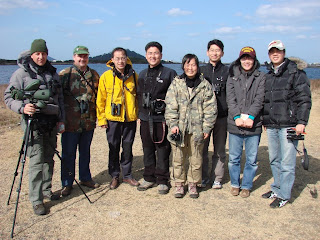
Monday, February 25, 2008
Monday was devoted to Fairy Pitta research. Eun-Mi Kim, Chang-Wan Kang, Ruey-Shing Lin, and Mark Wilkie spent the day visiting and viewing Fairy Pitta habitat and known previous nesting sites. Fairy Pitta arrive in Jeju in mid to late May. This is about a month later than those arriving in Taiwan. 
Tuesday, February 26, 2008
We planned to visit two nesting sites on Tuesday morning before our flight back to Taiwan. Because of weather conditions we were only able to visit one site. Snow prevented us from getting to the second site.
Conclusion
The Workshop was a great success. For us, it helped in establishing future cooperation for Fairy Pitta research and conservation and gave us all a better understanding of where research is at in South Korea and Taiwan. It also gave us a greater understanding of threats to the species within its international range. It allowed us to share ideas. Eun-Mi Kim will be coming to Taiwan in late April for about a week. She will deliver a presentation to the Taiwan Endemic Species Research Institute and also spend time in the field in the Huben-Hushan area with Dr. Lin and his team.
Acknowledgements and thanks
Firstly, our thanks goes to the Jeju Wildlife Research Center for inviting us to their annual workshop and hosting us. It was indeed a great honour to be able to deliver our presentations at their workshop alongside some of South Korea's most respected researchers.
We were overwhelmed by the hospitality of the Jeju Wildlife Research Center and its members. They really made us most welcome and extended the very best of Jeju hospitality to us. Thank you ! Special thanks must also go to Eun-Mi Kim, and Chang-Wan Kang for all of their work and our grateful appreciation to our friends Nam-Joon Ji, Hee-Man Kang, Yong-chang Jang, Young-Ho Kim, Wan-Byung Kim, and Charlie who made our trip so memorable.
Our appreciation also extends to our fellow delegates Dr. Jin-Young Park, Dr. Hwa-Jung Kim, Dr. Woong-Seo Kim, and Barry Heinrich for sharing their knowledge with us and making the field trips so memorable.
Finally, our thanks to Wild at Heart Legal Defense Association for their support and for the funding of the air travel.
List of birds seen during the Jeju Workshop field trips
Bird List
Phasianus colchicus Common Pheasant
Anser fabalis Bean Goose
Anser erythropus Lesser White-fronted Goose
Aix galericulata Mandarin Duck
Tadorna tadorna Common Shelduck
Anas strepera Gadwall
Anas penelope Eurasian Wigeon
Anas platyrhynchos Mallard
Anas poecilorhyncha Spot-billed Duck
Anas clypeata Northern Shoveler
Anas acuta Northern Pintail
Anas crecca Common Teal
Aythya ferina Common Pochard
Aythya fuligula Tufted Duck
Bucephala clangula Common Goldeneye
Mergus serratorRed-breasted Merganser
Mergus merganser Common Merganser
Columba livia Rock Pigeon
Streptopelia orientalis Oriental Turtle-Dove
Gallinula chloropus Common Moorhen
Fulica atra Common Coot
Tringa ochropus Green Sandpiper
Tringa hypoleucos Common Sandpiper
Calidris alpina Dunlin
Pluvialis squatarola Grey Plover
Vanellus vanellus Northern Lapwing
Larus crassirostris Black-tailed Gull
Larus glaucescens Glaucous-winged Gull
Larus hyperboreus Glaucous Gull
Larus argentatus Herring Gull
Larus mongolicus Mongolian Gull
Larus heuglin Heuglin's Gull
Larus schistisagus Slaty-backed Gull
Rissa tridactyla Black-legged Kittiwake
Pandion haliaetus Osprey
Milvus migrans Black Kite
Buteo buteo Common Buzzard
Circus spilonotus Eastern Marsh-Harrier
Accipiter nisus Eurasian Sparrowhawk
Accipiter gentilis Northern Goshawk
Aquila clanga Greater Spotted Eagle
Falco tinnunculus Common Kestrel
Falco peregrinus Peregrine Falcon
Tachybaptus ruficollis Little Grebe
Podiceps cristatus Great Crested Grebe
Podiceps nigricollis Black-necked Grebe
Phalacrocorax carbo Great Cormorant
Phalacrocorax capillatus Japanese Cormorant
Phalacrocorax pelagicus Pelagic Cormorant
Egretta garzetta Little Egret
Egretta sacra Pacific Reef-Egret
Ardea cinerea Grey Heron
Casmerodius albus Great Egret
Nycticorax nycticorax Black-crowned Night-Heron
Platalea leucorodia Eurasian Spoonbill
Platalea minor Black-faced Spoonbill
Gavia stellata Red-throated Loon
Gavia arctica Arctic Loon
Gavia pacifica Pacific Loon
Lanius bucephalus Bull-headed Shrike
Pica pica Black-billed Magpie
Corvus frugilegus Rook
Corvus macrorhynchos Large-billed Crow
Monticola solitarius Blue Rock-Thrush
Zoothera dauma Scaly Thrush
Turdus pallidus Pale Thrush
Turdus eunomus Dusky Thrush
Tarsiger cyanurus Orange-flanked Bush-Robin
Phoenicurus auroreus Daurian Redstart
Parus ater Coal Tit
Parus major Great Tit
Parus varius Varied Tit
Regulus regulus Goldcrest
Ixos amaurotis Brown-eared Bulbul
Zosterops japonicus Japanese White-eye
Cettia diphone Japanese Bush-Warbler
Alauda arvensis Eurasian Skylark
Passer montanus Eurasian Tree Sparrow
Motacilla alba White Wagtail
Motacilla cinerea Grey Wagtail
Anthus hodgsoni Olive-backed Pipit
Anthus rubescens Buff-bellied Pipit
Carduelis sinica Oriental Greenfinch
Carduelis spinus Eurasian Siskin
Coccothraustes coccothraustes Hawfinch
Eophona migratoria Yellow-billed Grosbeak
Eophona personata Japanese Grosbeak
Emberiza cioides Meadow Bunting
Emberiza elegans Yellow-throated Bunting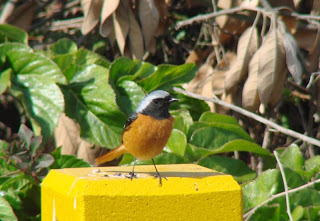
Phoenicurus auroreus 
Mammals
Roe Deer Capreolus pygarus tianschanicus
Also see:
Korean Fairy Pitta researcher visits Huben
Abstracts
A review and perspective of Fairy Pitta research in Taiwan
Ruey-Shing Lin (1), Wan-Jyun Chen (2), and Pei-Fen Lee (2)
1. Taiwan Endemic Species Research Institute, 1 Ming-Shen East Road, Jiji, Nantou 552, Taiwan.
2. Institute of Ecology and Evolutionary Biology, National Taiwan University, Taipei 106, Taiwan.
ABSTRACT
Tropical and subtropical Asia is currently confronting particularly severe forest conversion pressure. The vulnerable Fairy Pitta (Pitta nympha) is an understudied passerine which breeds in the low-elevation forests of eastern Asia and probably winters on Borneo. Because of severe habitat loss, suitable habitat within its breeding and wintering ranges as well as on its migration routes might not be sufficient to maintain its population. Additionally, there are few published intensive studies on migrating pitta species. Thus, there is an urgent need to establish knowledge of all aspects of their ecology and biology and then to propose suitable management measures to conserve this threatened species. In this speech, I will first illustrate what we have done between 2001 and 2007 in Taiwan, and then make a brief introduction to some of our ongoing research projects. Finally, I will outline a conservation plan for the Fairy Pitta over the next decade based on our current knowledge.
Historically, Fairy Pitta was believed to be a rare summer breeder in Taiwan. After a preliminary survey in Huben Village, Linnei Township, Yunlin Couty in west-central Taiwan in 2000, we found it probably was not as rare as previously thought and we thereafter initiated long term studies. At first, we tested the effectiveness of using playback of recorded calls to census the presence and abundance of Fairy Pitta in early summer of 2001. Since the detectivity of Fairy Pitta was significantly increased when playback was used, we then started using playback to survey the distribution of Fairy Pitta and to monitor the population status on different spatial scales, i.e., Huben Village, Linnei Township and Douliou City, and finally the whole of Taiwan. Additionally, the data was used to model the potential spatial distribution in areas we did not visit.
The diet of nestling Fairy Pitta was also studied by videotaping from 2000 to 2002. Results indicated that Earthworms were the most important food item for all broods and occurred in more than 73% of the adult’s feeding visits. Also, adults usually brought 1-3 items at each feeding visit to nestlings, and the prey sizes were usually 2-10 cm in length. The total number of food provisionings to provide food for nestlings was estimated to be around 900-1000 based on a brood observed for the entire nestling period.
In order to propose feasible habitat management strategies for land managers, we studied nest site selection and the possible effects of habitat conversions, i.e., bamboo plantation, over three breeding seasons from 2004 to 2006 on Fairy Pitta in Huben Village where the area is predominantly planted with bamboo (Dentrocalamus latiflorus). In general, Fairy Pitta chose to nest in areas with increased canopy cover and a diversity of trees coupled with decreased shrub density immediately around the nest and moderate small shrub density near the nest and situated at a moderate distance from the nearest tree. Also, nests built in places with higher overhead cover, with a steeper downward slope and with greater difficulty to access were more successful. Although bamboo density was not included in the best nest site selection models, it did significantly negatively correlate with the diversity of trees. Therefore, we recommend that managers protect remaining broadleaf forests and restore similar habitat in areas of rough terrain, usually found along valleys, to enlarge areas of suitable habitat.
Since nest predation is the most important factor causing nest failure for Fairy Pitta, we monitored their breeding success in Huben Village from 2003 to 2007 and identified their nest predators by continuously digital video-taping during the 2006 and 2007 breeding seasons. Snakes were the most important predators, followed by large mammals, such as macaque, mongoose and civet. A Crested Serpent Eagle was observed once attacking nestlings.
Finally, we report on some resighting records from 152 color-banded Fairy Pittas that were captured in 2001, 2004 and 2005 to index their breeding site fidelity and to compare the differences in return ratios between adults and fledglings, and also between males and females within the Huben Village study area. Between 2004 and 2007, we resighted Fairy Pitta with bands 19 times, and of those, ten individuals were identified from fifteen resightings. The return ratio of fledglings (1/99) was significantly lower than it was in the adults (9/53). Among nine adults, only two were female. However, the difference between the two genders was not significant. The mean distance between banded and resighted positions was around 130m, ranging from 19-300m. Since the diameters of the various Fairy Pittas’ territories also ranged from 100-300m, it indicated that adults often returned to sites close to or in their original territories. The return rate of adults in Huben Village was around 16-26%. However, this value has probably been underestimated because of their secretive habits.
Currently, we are using the telemetry technique to study the fluctuations of home range and activity pattern within the breeding cycle and the movement and survival rates of young and adults during the period that Fairy Pitta stay in Taiwan. In addition, we are refining the spatial prediction models of Fairy Pitta in Taiwan and trying to estimate their population size. Probably, we will also model their spatial distribution within their breeding and wintering range. Since the connections between breeding and wintering populations are important for the conservation of Fairy Pitta, we plan to use molecular approach and isotopes to construct the spatial population structure among South Korea, Japan, China and Taiwan. If the population structure is significant, we then can use these tools to link the breeding and wintering populations in the future.
Conservation research of the migratory Fairy Pitta is generally more complicated than the other non-migratory pitta species. Based on the status quo and analyses of priorities, we outline current issues, set conservation goals and propose actions to accelerate the conservation of the Fairy Pitta over the next decade.
Conservation Issues
Inadequate understanding of population size and distribution, especially in south-east China and in its wintering range: Sighting records and surveys in small areas has been compiled. However, no extensive surveys across its distribution range have been made. Additionally, the actual wintering grounds for the species, has until now, remained somewhat of a myth.
Habitat loss, degradation, and fragmentation: Breeding habitats in south-east China and wintering habitats probably have been destroyed at a rapid rate. In other breeding areas, afforestation and modification in broadleaf forests have continuously degraded the remaining habitat.
More research work: Research is urgently needed on the ecology of habitat requirements, especially on specific structural features, landscape configurations, and amounts of habitat that are required to maintain a source sub-population in developing scientifically based management measures, such as designs of land-use projects, protected areas and habitat restoration.
Impact of climate change: Although the impact is not clear, it has the potential to affect the Fairy Pitta population through increasing temperature and uncertainties in rainfall that will certainly affect its distribution, food resources, and habitat requirements, and also through the changes in weather patterns on migration routes.
Conservation goals
Improve our understanding of the distribution of Fairy Pitta and its habitat requirements.
Initiate an international conservation action plan to reflect current knowledge.
Promote a coordinated international network of conservation partners to implement the action conservation plan.
Recommended actions
Conduct surveys throughout their distribution range to assess their population, distribution and conservation status.
Implement a standardized monitoring program within the breeding range. This is critical for all stages of conservation planning and important for monitoring their population trend, especially before the identification of wintering grounds.
Identify critical wintering habitat and study the linkage between breeding and wintering populations. These are necessary for protection and restoration because areas of their wintering habitat might be severely degraded in the near future. Methods for identifying the wintering grounds should be developed.
Monitor and track the amount, condition and configuration of the important habitat used in all phases of the Fairy Pitta annual cycle by GIS and remote sensing techniques.
Conduct research to identify areas of high-quality habitat and landscapes in terms of fecundity and survival across their annual cycle, and frequency and scale of dispersal among populations across their range. This information is valuable for their conservation.
Create well-coordinated partnerships to accelerate the implementation of conservation actions in nations where the Fairy Pitta stays or passes through.
Protect known important hotspots and retain remaining high-quality habitat. Restore similar habitat to defragmented and enlarged forest tracts that are large enough to support several source populations and other priority species. Also, examine the birds’ responses to management measures.
Develop community-involvement and scientifically sound forest management measures in areas of important breeding habitat.
The challenges of Fairy Pitta conservation reflect the status quo of many threatened forest birds in this region. To effectively conserve migratory landbirds, it is necessary to raise more conservation awareness and place more effort on carrying out well-coordinated monitoring studies beyond political borders.
Conservation and threats to the Fairy Pitta Pitta nympha:
The Huben IBA, Taiwan.
Mark Bruce Wilkie
Wild at Heart Legal Defense Association,
12F.86 Chongcing South Road Section 1, Taipei 10045, Taiwan.
Abstract
Taiwan falls within in the breeding range of the Fairy Pitta (Pitta nympha). In mid to late April this dazzling insectivorous terrestrial suboscine passerine arrives in Taiwan to breed. The Fairy Pitta has been listed as vulnerable (BirdLife International 2001) due to a sharp decline in numbers. The Huben Important Bird Area (IBA) in Yunlin County, west-central Taiwan is an important breeding area for the species. Taiwan has a total of 53 internationally identified IBAs. For its size, Taiwan has a very high number of IBAs. Only 11 or 21% fall within totally protected areas. 17 IBAs or 32% fall within partially protected areas. That leaves 25 or 47% of Taiwan’s IBAs without any protection. Huben falls amongst those IBAs without any protection (BirdLife International 2004).
The Huben-Hushan area has been listed as one of Asia’s key sites for conservation (Birdlife, 2004). The details of the Huben IBA are as follows:-
Name: Huben IBA.
Number: TW017.
Category: A1.
Admin Region: Yunlin County.
Coordinates: 23° 43’N 120° 36’E.
Altitude (highest point): 519m.
Area: 2,200 ha.
Habitats: Artificial landscapes (terrestrial); Forest.
Threatened Species: Fairy Pitta Pitta nympha.
Protected Area Status of the IBA: Unprotected.
In this presentation delegates will be introduced to the Huben IBA and the threats facing it, most notably, loss of habitat through construction-related so-called development projects such as the Hushan Dam Project and the concreting and barricading of streams to allegedly reduce erosion. In many ways the Huben IBA can be seen as a microcosm of what is happening to the Fairy Pitta throughout its range. Briefly, some of the conservation measures and efforts that have been taken to address the plight of this species will be looked at. Finally, the point that meaningful Fairy Pitta conservation can’t take place without international cooperation is made in the hopes that a multinational effort to address the plight of this delightful forest passerine can be brought about.
Posted by
Wild at Heart Legal Defense Association
at
10:51 AM
0
comments
![]()






























